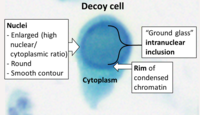
Photo from wikipedia
Importance We describe the first report to our knowledge of cutaneous and systemic pathogenicity of human polyomavirus 9 in solid organ transplant recipients. Objective Three solid organ transplant recipients developed… Click to show full abstract
Importance We describe the first report to our knowledge of cutaneous and systemic pathogenicity of human polyomavirus 9 in solid organ transplant recipients. Objective Three solid organ transplant recipients developed a widespread, progressive, violaceous, and hyperkeratotic skin eruption. All died from pulmonary and multiorgan failure around 1 year from onset of the rash. Routine clinical diagnostic testing could not identify any causative agent; therefore, samples and autopsies were investigated for novel pathogens using high-throughput sequencing. Design, Setting, and Participants This case series, including 3 solid organ transplant recipients who developed characteristic pink, violaceous, or brown hyperkeratotic papules and plaques throughout the body, was conducted at the Columbia University Medical Center. Lesional skin biopsies were collected from all 3 patients and subjected to high-throughput illumina sequencing for identification of microbial pathogens. Human polyomavirus 9 was identified in lesional skin biopsies. We subsequently collected ocular swabs, oral swabs, urine samples, and blood samples from patients, and organ tissues at autopsy in 1 patient. We investigated these samples for the presence of human polyomavirus 9 using in situ hybridization and quantitative polymerase chain reaction (PCR) assays. Main Outcomes and Measures A description of the clinical and pathologic findings of 3 patients. Results This case series study found that human polyomavirus 9 was detected in the skin biopsies of all 3 patients by a capture-based high-throughput sequencing method platform (VirCapSeq-VERT). Human polyomavirus 9 was also detected in blood, oral, ocular swabs, and urine by real-time polymerase chain reaction (PCR) assay. In situ hybridization and quantitative PCR assays were performed on the skin biopsies from 3 patients and lung autopsy of 1 patient, which showed the presence of human polyomavirus 9 messenger RNA transcripts, indicating active viral replication and pathogenesis in the skin and lungs. Conclusions and Relevance Human polyomavirus 9 was associated with the widespread cutaneous eruption. All 3 patients had progression of cutaneous disease, accompanied by clinical deterioration, pulmonary failure, and death. One patient underwent autopsy and human polyomavirus 9 was identified in the lungs and paratracheal soft tissue. These findings suggest that human polyomavirus 9 may be associated with cutaneous and possibly pulmonary infection and death in solid organ transplant recipients.
Journal Title: JAMA dermatology
Year Published: 2022
Link to full text (if available)
Share on Social Media: Sign Up to like & get
recommendations!